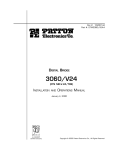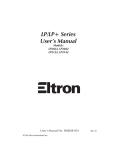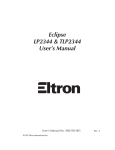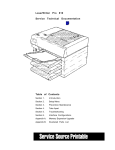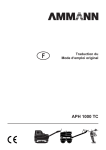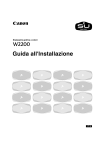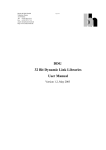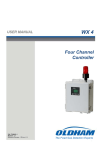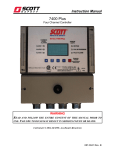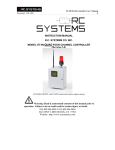Download Patton electronic 3040/V35 User's Manual
Transcript
B Doc #: 139001UA Part #: 07M3040-A DIGITAL BRIDGE 3040/V35 (CTS MD-V.35/TCB) INSTALLATION AND OPERATIONS MANUAL June 10, 1997 An ISO-9001 Certified Company Copyright© 2000 Patton Electronics Co., All Rights Reserved PATTON ELECTRONICS CO. 3040/V35 INSTALLATION AND OPERATIONS MANUAL 139001UA COPYRIGHT NOTICE Copyright© 2000 Patton Electronics Co., All Rights Reserved. PROPRIETARY NOTICE The information contained herein is proprietary and confidential to Patton Electronics Co. Any reproduction or redistribution of this publication, in whole or in part, is expressly prohibited unless written authorization is given by Patton Electronics Co. SERVICE All warranty and non-warranty repairs must be returned freight prepaid and insured to Patton Electronics. All returns must have a Return Materials Authorization number on the outside of the shipping container. This number may be obtained from Patton Electronics Technical Services at: tel: (301) 975-1007; email: [email protected]; or, www: http://www.patton.com. NOTE: Packages received without an RMA number will not be accepted. Patton Electronics’ technical staff is also available to answer any questions that might arise concerning the installation or use of your Patton MSDs. Technical Service hours: 8AM to 5PM EST, Monday through Friday. PUBLICATION NOTICE This manual has been compiled and checked for accuracy. The information in this manual does not constitute a warranty of performance. Patton reserves the right to revise this publication and make changes from time to time in the content thereof. Patton assumes no liability for losses incurred as a result of out-of-date or incorrect information contained in this manual. i PATTON ELECTRONICS CO. 3040/V35 INSTALLATION AND OPERATIONS MANUAL 139001UA EMISSION REQUIREMENTS RADIO AND TV INTERFERENCE The Patton devices generate and use radio frequency energy, and if not installed and used properly—that is, in strict accordance with the manufacturer’s instructions—may cause interference to radio and television reception. The Patton devices have been tested and found to comply with the limits for Class A computing devices in accordance with the specifications in Subpart J of Part 15 of FCC rules, which are designed to provide reasonable protection from such interference in a commercial installation. However, there is no guarantee that interference will not occur in a particular installation. If the Patton devices do cause interference to radio or television reception, which can be determined by disconnecting the cables, the user is encouraged to try to correct the interference by one or more of the following measures: moving the computing equipment away from the receiver, re-orienting the receiving antenna, and/or plugging the receiving equipment into a different AC outlet (such that the computing equipment and receiver are on different branches). CANADIAN EMISSIONS This digital apparatus does not exceed the Class A limits for noise emmissions from a digital apparatus set out in the Radio Interference Regulations of the Canadian Department of Communications. Le present appareil numerique n’emet pas de bruits redioelectriques depassant les limites applicables aux appareils numeriques de la Class A prescites dans le Reglement sur le brouillage redioelectrique edicte par le ministere des Communications du Canada. ii PATTON ELECTRONICS CO. 3040/V35 INSTALLATION AND OPERATIONS MANUAL 139001UA Contents CHAPTER 1 - OPERATION Channel Clocking ............................................................................................................................... 1-1 Fallback Clocking ............................................................................................................................... 1-1 Channel Interface ............................................................................................................................... 1-1 Anti-streaming .................................................................................................................................... 1-2 Channel Selection Modes .................................................................................................................. 1-2 Channel Tail Circuits ......................................................................................................................... 1-3 Interface Connections ........................................................................................................................ 1-4 Front Panel LEDs .............................................................................................................................. 1-4 Channel Enable / Disable Switches .................................................................................................. 1-4 Power Supply ..................................................................................................................................... 1-4 CHAPTER 2 - SETUP AND INSTALLATION Power Connection ............................................................................................................................. 2-1 Factory Configuration Switch Settings .............................................................................................. 2-1 Disassembly ...................................................................................................................................... 2-2 Installation .......................................................................................................................................... 2-2 Equipment Grounding (SW15-1) ....................................................................................................... 2-3 RTS To CTS Delay (SW16-1,2,3) ..................................................................................................... 2-3 Anti-Streaming (SW18-1,2,3) ............................................................................................................ 2-3 Receive Data Mode (SW18-7) .......................................................................................................... 2-3 Control Turn-Off Delay in “DATA” Switching Mode (SW15-3,4) ....................................................... 2-4 Switch on Data / Control (SW17-5,6,7,8) .......................................................................................... 2-4 Internal Baud Rates (SW15-5,6,7,8) ................................................................................................. 2-4 Fallback Clock Enable (SW16-7) ...................................................................................................... 2-5 Fallback Clocking From Sub-Channel 4 (SW16-8) ........................................................................... 2-5 Fallback Mode Selection (SW16-6) ................................................................................................... 2-5 TX Clock Source Selection (SW17-1,2,3) ......................................................................................... 2-6 TX Clock Pin Selection (SW17-4) ..................................................................................................... 2-6 RX Clock Source Selection (SW18-4,5,6) ........................................................................................ 2-6 Tail Circuit Buffers (SW16-4) ............................................................................................................ 2-7 Port DCE/DTE Selection (SW5 thru SW14) ..................................................................................... 2-7 DTR / DSR Forced Active (JP8 thru JP12) ....................................................................................... 2-8 FACTORY Test Jumpers (JP1, JP2 and JP3) .................................................................................. 2-8 APPENDIX Typical Application .............................................................................................................. A-1 Typical Tail Circuit Configuration ......................................................................................... A-1 Interface Pins Supported ..................................................................................................... A-2 Master DTE / Sub-Channel DTE Interface Flow Diagram .................................................... A-3 Master DTE / Sub-Channel DCE Interface Flow Diagram .................................................... A-3 Master DCE / Sub-Channel DCE Interface Flow Diagram ................................................... A-4 Master DCE / Sub-Channel DTE Interface Flow Diagram .................................................... A-4 TECHNICAL SPECIFICATIONS.......................................................................................... A-5 Strapping Guide .................................................................................................................. A-6 iii PATTON ELECTRONICS CO. INSTALLATION AND OPERATIONS MANUAL 3040/V35 139001UA CHAPTER 1 - OPERATION The Patton 3040/V35 (CTS MD-V.35/TCB) is a network enhancement accessory intended for high speed synchronous or asynchronous V.35 modem, DSU/CSU, or port sharing applications. The 3040/V35 (CTS MD-V.35/TCB) allows for immediate expansion of a system without the requirement of additional communication lines. The 3040/V35 (CTS MDV.35/TCB) allows any combination of up to four V.35 DCE or DTE devices to share a single V.35 DCE or DTE high speed link in a point-to-point or multi-point polled network. Channel Clocking The 3040/V35 (CTS MD-V.35/TCB) is protocol transparent and operates in synchronous and asynchronous environments at data rates up to 2.048Mbps, depending on cable length and attached equipment. Clocking can be derived from the Master Port clock, (pins Y,AA for TT or U,W for ETT and V,X for RT), the internal clock generator or any Sub-Channel clock, (pins Y,AA for TT or U,W for ETT and V,X for RT). Fallback Clocking In the event of loss of an externally provided clock or optionally Sub-Channel 1 DCD becoming inactive, the 3040/V35 (CTS MD-V.35/TCB) has the ability to automatically fall back to the predetermined internal baud rate clock or the Sub-Channel 4 RX Clock (pins V,X). Channel Interface The 3040/V35 (CTS MD-V.35/TCB) has five V.35 (MR-34) female connectors located on the rear of the unit. Also a DB-25 connector is provided in parallel with the Master Port V.35 connector. Each port is DCE/DTE selectable, which eliminates the need for crossover cables. DSR or DTR can additionally be forced to the active state individually on each Sub-Channel by Jumper control. 3040/V35 S UB-CH ANN EL STATUS ENABLE/DISABLE STREAM ACTIVE PW SD RD FB 1 2 3 4 1 1-1 2 3 4 1 2 3 4 OPERATION PATTON ELECTRONICS CO. 3040/V35 INSTALLATION AND OPERATIONS MANUAL 139001UA Anti-streaming A typical problem often encountered is a “STREAMING” remote terminal. The streaming problem can tie up an entire circuit until the offending device has recovered or is powered down. A streaming condition occurs when a Sub-Channel remains active, disrupting the polling sequence. The 3040/V35 (CTS MD-V.35/TCB) provides two user selectable modes of controlling a streaming condition, an automatic anti-streaming Abort Timer with eight selectable block lengths and a setting to disable anti-streaming for large data block transfers, and a manual Operator Control mode (front panel push button switch). Automatic Anti-streaming - Automatic Anti-Streaming will block the asserted control signal from the Sub-Channel Port, releasing the 3040/V35 (CTS MD-V.35/TCB) to accept requests from any other Sub-Channel that has not been locked out due to a streaming condition. When a Sub-Channel is locked out for streaming, a visual indication, by Sub-Channel, is provided on the front panel. The Sub-Channel will no longer receive data or CTS from the Master Port. Any data sent to the Master Port by the streaming device will be lost. Once a Sub-Channel is locked out due to streaming, the Sub-Channel will remain locked out until the attached device removes the streaming condition. If RTS is held active, RTS must become inactive, if continuous data transitions have triggered the Anti-Stream logic, the transitions must stop before the 3040/V35 (CTS MD-V.35/TCB) will clear the Anti-Stream logic to that Sub-Channel. Removing the Sub-Channel via the front panel disable switch will not clear the Anti-stream logic for a Sub-Channel once it has been activated. Manual Anti-Streaming - If manual Anti-Stream protection is chosen, a streaming condition caused by one of the attached terminals can be quickly corrected by the 3040/V35 (CTS MDV.35/TCB) via the associated front panel locking switches. A switch is provided for each SubChannel and permits the rapid removal of a streaming terminal without having to disconnect any cables or power down the offending terminal. Terminals may be selectively removed for self-test and maintenance without affecting the remaining Sub-Channels. Once the streaming condition has been corrected, the front panel switch is simply depressed to the locked (Enable) position (Green indicator ON) to re-establish normal operation. Removing a SubChannel with the front panel switch will block data from the Sub-Channel going to the Master Port but will not block data going from the Master Port to the Sub-Channel as the Automatic Anti-Stream option did. Channel Selection Modes The 3040/V35 (CTS MD-V.35/TCB) provides two selectable Sub-Channel service modes of operation, the Scanning Mode and Priority Mode. Depending on system requirements, either mode may be selected by internal DIP switch settings. Both modes switch on activity from the Sub-Channel. OPERATION 1-2 PATTON ELECTRONICS CO. 3040/V35 INSTALLATION AND OPERATIONS MANUAL 139001UA In the Scanning Mode the CTS 3040/V35 (CTS MD-V.35/TCB) scans each Sub-Channel, in sequence, beginning with Sub-Channel 1. This rotational sequence is repeated continually with each attached Sub-Channel having equal access to the communications link. When data or control lines from a Sub-Channel become active that Sub-Channel is switched through to the master port by the 3040/V35 (CTS MD-V.35/TCB). All remaining Sub-Channels are locked out until the first device becomes inactive. When the Sub-Channel device becomes inactive, the 3040/V35 (CTS MD-V.35/TCB) will resume scanning the Sub-Channels for another active signal. When configured for Priority Mode operation, the 3040/V35 (CTS MD-V.35/TCB) monitors all Sub-Channels simultaneously with Sub-Channel 1 having the highest priority. When a SubChannel becomes inactive, the 3040/V35 (CTS MD-V.35/TCB) will automatically default to the highest priority (lowest number) Sub-Channel with activity. Contention for the Master port is accomplished by asserting RTS (Request to Send) if the Sub-Port is configured as a DCE, DCD (Data Carrier Detect) if the Sub-Port is configured as a DTE or Data Transitions from the attached Sub-Channel devices in either configuration. The active interface lead, RTS or DCD, as well as selection of contention mode, “Data Transitions” or “Interface Lead” activation, can be selected on an individual basis for each Sub-Channel. Once a Sub-Channel asserts an active control signal the control signal will be passed through to the Master Port, depending on DTE / DCE configuration of the Sub-Channel and Master Port. This control will be passed without delays. If the Master Port is configured as a DTE the signal will be passed as RTS. The CTS returned to the Master will have an optional delay added before the signal is returned to the Sub-Channel port. Port Enable / Disable, front panel switches must be pushed in (GREEN indication) for a SubChannel to access the Master Port regardless of the mode of operation selected. Channel Tail Circuits A buffer is built into the unit for tail circuit (DCE to DCE) applications. An 8 bit centered ring buffer is used to correct the clock phasing errors generated between the Modem on the Master Port and the Sub-Channel port for the data transferred from the Sub-Channel to the Master Port. If the unit is operated in an asynchronous environment the buffer must be bypassed. This is accomplished by moving the SYNC/ASYNC switch to ASYNC. 1-3 OPERATION PATTON ELECTRONICS CO. 3040/V35 INSTALLATION AND OPERATIONS MANUAL 139001UA Interface Connections All connections are made via industry standard CCITT V.35 (MR-34) female connectors located on the rear of the unit. The Following interface leads are implemented, Chassis (A), TD (P,S), RD (R,T), RTS (C), CTS (D), DSR (E), Sig Gnd(B), DCD (F), TT (Y,AA), RT (V,X), DTR (H), ETT (U,W). In addition the master port can be accessed via an DB-25 with the following pinout, Chassis (1), TD (24,11), RD (23,22), RTS (4), CTS (5), DSR (6), Sig Gnd(7), DCD (8), TT (14,1), RT (16,3), DTR (20), ETT (15,2). Front Panel LEDs Front panel LEDs are provided to indicate power is applied, RD and TD activity from the Master Port, Sub-Channel activity of each individual Port, Anti-Stream condition of each SubChannel and an indication of clock Fallback condition. Channel Enable / Disable Switches Front panel switches allow operator intervention to remove an individual Sub-Channel from accessing the Master Port. Positive latching type switches are provided for each SubChannel port for isolating or removing a streaming terminal. The Sub-Channel is activated by IN pushing the switch until it is in the “IN IN” position. The switch will indicate GREEN in color. To OUT disable a Sub-Channel push the switch until it locks in the “OUT OUT” position, the switch will indicate BLACK in color. Disabling a Sub-Channel with the front panel does not prevent the Sub-Channel from receiving data from the Master Port only from sending data to the Master Port. Power Supply A linear power supply is located internally, an external 110/220VAC switch is located on the rear of the unit. If chassis ground and signal ground need to be tied together this can also be accomplished by switch selection. The unit is Rackmountable for 19" cabinets or optional 23" cabinets, by using the provided Rackmount Kit. Safety approvals granted are UL and CSA as well as emission approval for FCC Class A. OPERATION 1-4 PATTON ELECTRONICS CO. 3040/V35 INSTALLATION AND OPERATIONS MANUAL 139001UA Caution, Disconnect the POWER Before Removing The Cover Vorsicht, Befor Deckung Abnehmen Mach Strom Zu. CHAPTER 2 - SETUP AND INSTALLATION Power Connection 220 Before connecting the 3040/V35 (CTS MD-V.35/TCB) to a AC power source the top cover must be installed and secured with the supplied #8-32 screws. The unit is supplied with a 110/ 220VAC voltage switch, turn the switch with 110 / 220VA Switch Fuse Drawer a coin or screw driver to the appropriate voltage for your country. EXAMPLE: In WARNING: FOR CONTINUED PROTECTION 110 AGAINST RISK OF FIRE, REPLACE ONLY the United States of America; set to WITH SAME TYPE AND RATING FUSE. PORT 4 MASTER DTE/ DCE 110VAC. The unit is supplied with a IEC power connector next to the voltage select switch, plug the power cord into the connector until it is firmly IEC Power Connector seated. You may now connect the power cord into your AC outlet. Factory Configuration Switch Settings The 3040/V35 (CTS MD-V.35/TCB) is configured prior to shipment with the switches set to the following default positions: Switch 15 - 1,2,3, 4 and 8 to OFF OFF, 5, 6 and 7 to ON ON. No Data Time Out = 2048 bits Internal Baud Rate = 56000 Chassis Ground not connected to Signal Ground Switch 16 - All to ON ON. CTS Delay = No Delay Sync Mode Contention Mode = Priority Fallback Clock = Disabled Fallback Clock Mode = Data Transitions Fallback Clock Source = Internal Baud Rate Generator Switch 17 - All to ON ON. TX Clock Source = Master pin 15 Sub-Channel Activity Indicated by Interface Control (RTS/DCD) 2-1 SETUP & INSTALLATION PATTON ELECTRONICS CO. 3040/V35 INSTALLATION AND OPERATIONS MANUAL 139001UA Switch 18 - 1, 2, 3, 7 and 8 to OFF OFF, 4, 5 and 6 to ON Anti-Stream timer = 2 M bits Anti-Stream = Disabled Broadcast Data to Sub-Channels RX Clock Source = Master JP4 Thru JP7 Open HS Option Not Enabled JP8 thru JP12 to Open DTR / DSR Not Forced JP1 Thru JP3 to Installed Factory Test Jumpers If the system application requires one or more of the default settings to be changed, it will be necessary to remove the top cover of the enclosure to access and change the DIP switches located on the printed circuit board. Disassembly Remove the top cover by removing the phillips head screws located on the left and right sides of the 3040/V35 (CTS MD-V.35/TCB). DTE/DCE switches SW5 through SW14, baud rate Jumpers JP4 through JP7, interface Jumpers JP8 through JP12 and configuration switches SW15 through SW18 are located on the PCB as indicated on the strapping guide in the Appendix of this manual. After the switch selection activity is completed, re-install the top cover BEFORE connecting to a AC power source. Installation Select an appropriate location accessible to and within six feet of an AC power outlet, the outlet must have a ground pin receptacle for product warranty. The DCE-to-DTE cabling between each attached device and the 3040/V35 (CTS MD-V.35/TCB) should be “Straight Through”, shielded and terminated with male connectors. Sub-Channels are marked PORT 1 through PORT 4, the Master Port is marked, MASTER DCE/DTE. If any terminal has a priority service mode, ensure it is connected to the port connector designated “PORT 1” on the rear panel of the 3040/V35 (CTS MD-V.35/TCB). Secure other terminals or Modems to be serviced to the remaining “PORT” connectors. Connect the MODEM or TERMINAL to the connector designated “MASTER DTE/DCE”. SETUP & INSTALLATION 2-2 PATTON ELECTRONICS CO. 3040/V35 INSTALLATION AND OPERATIONS MANUAL 139001UA Equipment Grounding (SW15-1) Switch SW15-1 provides for grounding interconnection in those systems requiring a connection between (Frame Ground) and (Signal Ground). Connect ONLY if required. RTS To CTS Delay (SW16-1,2,3) If a CTS delay is desired, set SW16-1, 2 and 3 to the required value as indicated below. SW16-1 SW16-2 SW16-3 Time ON ON ON No Delay OFF ON ON 1mS ON OFF ON 2mS OFF OFF ON 4mS ON ON OFF 8mS OFF ON OFF 16mS ON OFF OFF 32mS OFF OFF OFF 64mS Anti-Streaming (SW18-1,2,3) The maximum data block size is user selectable via switch SW18- 1, 2 and 3. As shown below eight block sizes are provided to the user. To disable anti-streaming set SW18-8 to the OFF position. The maximum block size is normally defined at the time of installation. SW18-1 SW18-2 SW18-3 CLOCKS ON ON ON 1024 OFF ON ON 2048 ON OFF ON 4096 OFF OFF ON 16 K ON ON OFF 64 K OFF ON OFF 256 K ON OFF OFF 1 MEG OFF OFF OFF 2 MEG 2-3 SETUP & INSTALLATION PATTON ELECTRONICS CO. 3040/V35 INSTALLATION AND OPERATIONS MANUAL 139001UA Receive Data Mode (SW18-7) Setting switch SW18-7 to ON sets the 3040/V35 (CTS MD-V.35/TCB) into the Gated Mode. Only the Sub-Channel that is currently active will receive the data from the master port. Setting position 7 to OFF enables the Broadcast mode. Receive Data from the Master Port is sent to all Sub-Channels. Control Turn-Off Delay in “DATA” Switching Mode (SW15-3,4) When configured to switch on DATA, switch SW15-3 and 4 set the Sub-Channel release time in clocks. The value selected is the number of clocks at the current baud rate that must occur without any data transitions on the Sub-Channel to indicate that Sub-Channel has completed its transmission and the 3040/V35 (CTS MD-V.35/TCB) can resume servicing the other SubChannels. The following table should be used to set this time period. SW15-3 SW15-4 CLOCKS ON ON 16 ON OFF 64 OFF ON 256 OFF OFF 2048 Switch on Data / Control (SW17-5,6,7,8) Each sub-channel is independently selectable for switch on data or switch on an active interface control lead. Set SW17 pos 5 to OFF if sub-channel 1 switch on Data is required. Set pos 5 to ON if switch on interface control lead is desired. Position 6 thru 8 are associated with sub-channels 2 thru 4. Internal Baud Rates (SW15-5,6,7,8) Switch SW15-5, 6, 7 and 8 select the master clock rate when Internal Clock Source is selected on TX Clock Source or RX Clock Source. In addition the Fallback clock rate is also selected with this option. When Fallback clocking is required, the RX Clock Source and TX Clock Source should not be set to INTERNAL. SW15-5, 6, 7 and 8 selects the clock rate of the Fallback Clock when Internal Clock Fallback is selected. The following table shows the available rates. SETUP & INSTALLATION 2-4 PATTON ELECTRONICS CO. INSTALLATION AND OPERATIONS MANUAL 3040/V35 139001UA SW15-5 SW15-6 SW15-7 SW15-8 Rate ON ON ON ON HS Opt. OFF ON ON ON 768K ON OFF ON ON 384K OFF OFF ON ON 192K ON ON OFF ON 128K OFF ON OFF ON 72K ON OFF OFF ON 64K OFF OFF OFF ON 57.6K ON ON ON OFF 56K OFF ON ON OFF 48K ON OFF ON OFF 38.4K OFF OFF ON OFF 28.8K ON ON OFF OFF 19.2K OFF ON OFF OFF 14.4K ON OFF OFF OFF 9.6K OFF OFF OFF OFF 4.8K For the High Speed Option set SW15-5, 6, 7 and 8 to ON and select the desired rate by installing JP4 for 2048K, JP5 for 1024K, JP6 for 512K or JP7 for 256K. Only one of the four jumpers should be installed of proper operation. Fallback Clock Enable (SW16-7) If Clock Fallback is required when the primary clock fails, set switch SW16-7 to OFF OFF. If Fallback is not required set SW16-7 to ON ON. The Fallback clock rate is selected with the internal baud rate option. When the Fallback is activated the FBC LED will illuminate. Fallback Clocking From Sub-Channel 4 (SW16-8) To use the Sub-Channel 4 RX Clock as the Fallback clock set SW16-8 to OFF OFF. To use the Internal Baud Rate Clock as the Fallback clock set SW16-8 to ON ON. Fallback Mode Selection (SW16-6) If Fallback is required, two modes are available via switch SW16-6. To Fallback when the transitions from the primary clock source stop, set SW16-6 to ON ON. To Fallback when DCD on Sub-Channel 1 becomes inactive, set SW16-6 to OFF OFF. 2-5 SETUP & INSTALLATION PATTON ELECTRONICS CO. 3040/V35 INSTALLATION AND OPERATIONS MANUAL 139001UA NOTE: Both TX and RX Clock Source Select MUST Be Set !!!! TX Clock Source Selection (SW17-1,2,3) TX Clock Source is selected by switch SW17-1, 2 and 3. The following table indicates the source options provided by the 3040/V35 (CTS MD-V.35/TCB). When using the unit in Async Mode, the INTERNAL clock source must be selected. SW17-1 SW17-2 SW17-3 Source ON ON ON Master OFF ON ON Port 1 ON OFF ON Port 2 OFF OFF ON Port 3 ON ON OFF Port 4 OFF ON OFF unused ON OFF OFF unused OFF OFF OFF Internal Internal Must Be Selected For Async Operation TX Clock Pin Selection (SW17-4) The primary transmit clock can be derived from either pins Y,AA or pins U,W. If pins Y,AA are to be the source for primary TX Clock, set SW17-4 to ON ON. If pins U,W are to be the source for OFF. primary TX & RX Clock, set SW17-4 to OFF RX Clock Source Selection (SW18-4,5,6) RX Clock Source is selected by SW18-4, 5 and 6. The following table indicates the source options provided by the 3040/V35 (CTS MD-V.35/TCB). If the TXC source is pins U,W, both RXC and TXC will be sourced from pins U,W. When the unit is used in an Async network select INTERNAL as the source of the RX Clock. SETUP & INSTALLATION SW18-4 SW18-5 SW18-6 Source ON ON ON Master OFF ON ON Port 1 ON OFF ON Port 2 OFF OFF ON Port 3 ON ON OFF Port 4 OFF ON OFF unused ON OFF OFF unused OFF OFF OFF Internal 2-6 PATTON ELECTRONICS CO. 3040/V35 INSTALLATION AND OPERATIONS MANUAL 139001UA Tail Circuit Buffers (SW16-4) The 3040/V35 (CTS MD-V.35/TCB) has a Tail Circuit Buffer that is automatically selected when a Sub-Channel is set as a DTE. The buffer will provide clock synchronization of the data from the Sub-Channel to the Master Port for Tail Circuit operations. The buffer is de-activated when the Sub-Channel is configured as a DCE. When operating in an asynchronous environment the Buffer must be bypassed. To bypass the buffer in a synchronous or asynchronous application, set switch SW16-4 to OFF (ASYNC). For normal operation in a synchronous environment set SW16-4 to ON (SYNC). When using a tail circuit modem with the 3040/V35 (CTS MD-V.35/TCB), the modem connected to the Sub-Channel, should be set to External Transmit Clocking. The modem at the remote end of the connection should be set to RX-TX Clocking or Slaved TX Clock. This will insure the same clock is present throughout the network and clock slippage will not occur. Port DCE/DTE Selection (SW5 thru SW14) Slide switches SW5 through SW14 are used to configure DTE/DCE for each port. Slide Both switches associated with a port to the same position. Example: If connecting a modem (DCE Device) to the PORT, then the port should be configured as a DTE interface. Slide both switches to the DTE position toward the interface connector. If connecting a terminal (DTE) to the Sub-Channel, the port should be configured as a DCE. Slide both switched to the DCE position away from the interface connector. The port is always configured opposite to the interface that is to be connected to it. DCE J8 thru JP12 DCE Forced DSR/DTR 2-7 SETUP & INSTALLATION PATTON ELECTRONICS CO. 3040/V35 INSTALLATION AND OPERATIONS MANUAL 139001UA DTR / DSR Forced Active (JP8 thru JP12) DTR is tied to DSR on each of the Sub-Channel ports. If the device connected does not supply a DTR but requires DSR (DTE) or does not supply DSR but requires DTR (DCE), installing the forced DTR/DSR jumper (JP8-JP12) for the appropriate Sub-Channel will solve this problem. The line is forced to +8V via an 820W resistor, providing isolation to any driver that might be on the interface. Channel Jumper Channel Jumper Master JP8 3 JP11 1 JP9 4 JP12 2 JP10 FACTORY Test Jumpers (JP1, JP2 and JP3) The three test jumpers JP1, 2 and 3, must be installed for the unit to properly function. These jumpers are used in the manufacture and test of the product prior to shipment. SETUP & INSTALLATION 2-8 PATTON ELECTRONICS CO. INSTALLATION AND OPERATIONS MANUAL 3040/V35 139001UA APPENDIX V.35 V.35 Leased or Dial Line V.35 DSU/CSU V.35 3040/V35 3040/V35 V.35 DSU/CSU Leased or Dial Line Typical Application External TX Clocking TT-Y,AA Internal TX Clocking Data Data Data RT-V,X Slave TX Clocking RT-V,X ETT-U,W TT-Y,AA Data Slave TX Clocking ETT-U,W Data ETT-U,V TT-Y,AA RT-V,X Data RT-V,X Buffer Terminal Data Typical Tail Circuit Configuration A-1 APPENDIX PATTON ELECTRONICS CO. INSTALLATION AND OPERATIONS MANUAL 3040/V35 139001UA SG CD B F L RD(A) RT(A) R V CTS D J FG DSR A E RTS DTR C H RD(B) RT(B) T X N K M Z DD BB TD(A) ETT(A) TT(A) P U Y JJ FF CC TD(B) ETT(B) TT(B) S W AA NN LL HH EE MM KK M-34 Interface Pins Supported DB-25 V.35 1 2 3 4 5 6 7 8 9 10 11 12 13 Transmit Clock(A) (from DCE) 14 External Transmit Clock(A) (from DTE) 15 Receive Clock(A) (from DCE) 16 17 18 19 Data Terminal Ready (from DTE) 20 21 Receive Data(B) (from DCE) 22 Receive Data(A) (from DCE) 23 Transmit Data(A) (from DTE) 24 25 Transmit Clock(B) (from DCE) External Transmit Clock(B) (from DTE) Receive Clock(B) (from DCE) Request to Send (from DTE) Clear To Send (from DCE) Data Set Ready (from DCE) Signal Ground (common) Data Carrier Detect (from DCE) Transmit Data(B) (from DTE) DB-25 Interface Pins Supported APPENDIX A-2 PATTON ELECTRONICS CO. 3040/V35 INSTALLATION AND OPERATIONS MANUAL 139001UA Master Port is a DTE Channel Port is a DTE Pins R,T RD Pins P,S TD Buffer Pins P,S TD Clk Out Pin C RTS Clk In +8v Pin D CTS Pins R,T RD Pin C RTS Pin D CTS Pin E DSR Pin F DCD Pin H DTR Pins Y,AA TT Master TX Clock Selection Logic Pin E DSR Pin F DCD Pin H DTR Pins Y,AA TT Pins V,X RT Pins U,W ETT Master RX Clock Selection Logic Pins V,X RT Pins U,W ETT Switch Control Master DTE / Sub-Channel DTE Interface Flow Diagram Channel Port is a DCE Master Port is a DTE Pins R,T RD Pins R,T RD Pins P,S TD Switch Control Pin C RTS Pin D CTS Pins P,S TD Pin C RTS Pin D CTS Pin E DSR Pin F DCD Pin H DTR Pins Y,AA TT Master TX Clock Selection Logic Pin E DSR Pin F DCD Pin H DTR Pins Y,AA TT Pins V,X RT Pins U,W ETT Master RX Clock Selection Logic Pins V,X RT Pins U,W ETT Master DTE / Sub-Channel DCE Interface Flow Diagram A-3 APPENDIX PATTON ELECTRONICS CO. 3040/V35 INSTALLATION AND OPERATIONS MANUAL 139001UA Channel Port is a DCE Master Port is a DCE Pins P,S TD Pins R,T RD Pins R,T RD Switch Control Pin C RTS Pin C RTS Pin D CTS Pin D CTS Pin E DSR Pin F DCD Pin H DTR Pins Y,AA TT Pins P,S TD +8v +8v Master TX Clock Selection Logic Pins V,X RT Pins U,W ETT Pin E DSR Pin F DCD Pin H DTR Pins Y,AA TT Pins V,X RT Pins U,W ETT Master RX Clock Selection Logic Master DCE / Sub-Channel DCE Interface Flow Diagram Channel Port is a DTE Master Port is a DCE Pins P,S TD Pins P,S TD Pins R,T RD Buffer Clk Out Pin C RTS Clk In +8v Pin D CTS Pin E DSR Pin F DCD Pin H DTR Switch Control +8v Pins Y,AA TT Master TX Clock Selection Logic Pins V,X RT Pins U,W ETT Master RX Clock Selection Logic Pins R,T RD Pin C RTS Pin D CTS Pin E DSR Pin F DCD Pin H DTR Pins Y,AA TT Pins V,X RT Pins U,W ETT Master DCE / Sub-Channel DTE Interface Flow Diagram APPENDIX A-4 PATTON ELECTRONICS CO. 3040/V35 INSTALLATION AND OPERATIONS MANUAL 139001UA TECHNICAL SPECIFICATIONS Applications Sub-Channel Interface Multiple V.35 Sync or Async DCE or DTE devices sharing one V.35 DCE or DTE link CCITT V.35 female connectors (MR-34) Master Interface Capacity CCITT V.35 female connector (MR-34 & DB-25) One to Four V.35 Sync or Async DTE or DCE devices One V.35 DCE or DTE Master Channel Data Format Data transparent at all data rates Front Panel Indicators: ..... Power, Send Data, Receive Data, Clock Fallback, Sub-Channel Active, Sub-Channel Stream Switches: ...... Enable/Disable each Sub-Channel Data Rates Power Source Up to 2.048Mbps Timing Internal: ...... DIP switch selectable Normal: ...... From Modem External: ...... Clock provided on any Sub-Channel 100-120/200-240 Vac, 50 to 60 Hz, 0.16/0.08 A, Switch Selectable Environmental Anti-streaming Operating Temp: ....... 32° to 122°F (0° to 50°C) Relative Humidity: ..... 5 to 90% non-condensing Altitude: .................. 0 to 10,000 feet Automatic:Selectable timeout intervals or disable Dimensions Terminal Service Modes Height: ....... 1.75 inches (4.44 cm) Width: ....... 17.00 inches (43.18 cm) Length: ....... 11.00 inches (18.93 cm) Scanning Mode: ...... Channels are continuously scanned for activity on a sequential basis. Priority Mode: ........ Channels are simultaniously monitored channel one has highest access Weight 4.5 lbs (2.1 Kg) A-5 APPENDIX SW7 SW8 SW9 SW10 SW11 SW12 SW13 SW14 256Kbps 512Kbps 1024Kbps 2048Kbps Fall Back Clocking ON Baud Rate Select - SW15 6 7 8 Rate 5 ON ON ON ON HS Option OFF ON ON ON 768K ON OFF ON ON 384K OFF OFF ON ON 192K ON ON OFF ON 128K OFF ON. OFF ON. 72K ON OFF OFF ON. 64K OFF OFF OFF ON 57.6K ON ON ON OFF 56K OFF ON. ON OFF 48K ON. OFF ON OFF 38.4K OFF OFF ON OFF 28.8K ON. ON OFF OFF 19.2K OFF ON. OFF OFF 14.4K ON. OFF OFF OFF 9.6K OFF OFF OFF OFF 4.8K OF F ON TX Clock Source - SW17 2 3 1 Source ON ON ON Master OFF ON ON Chan1 ON OFF ON Chan2 OFF OFF ON Chan3 ON ON OFF Chan4 OFF ON OFF Unused ON OFF OFF Unused OFF OFF OFF Internal 8 7 6 5 4 3 2 1 OF F Anti-Stream Timer Rx Clock Source Rcvr Gated=ON /Broadcast=OFF Anti-Stream Enabled=ON ON RX Clock Source - SW18 5 6 4 Source ON ON ON Master OFF ON ON Chan1 ON OFF ON Chan2 OFF OFF ON Chan3 ON ON OFF Chan4 OFF ON OFF Unused ON OFF OFF Unused OFF OFF OFF Internal Anti-Stream Timer - SW18 2 3 1 Count ON ON ON 1024 OFF ON ON 2048 ON OFF ON 4096 OFF OFF ON 16K ON ON OFF 64K OFF ON OFF 256K ON OFF OFF 1M OFF OFF OFF 2M Port Enable(Green) / Disable(Black) Active Anti-Stream 12 3 4 1 23 4 INSTALLATION AND OPERATIONS MANUAL HS Option OF F Tx Clock Source TXC pinsY,AA=ON / pinsU,W=OFF Ch1 RTS=ON /Data=OFF Ch2 RTS=ON /Data=OFF Ch3 RTS=ON /Data=OFF Ch4 RTS=ON /Data=OFF JP12 Port 4 ON CTS Delay Sync=ON /Async=OFF Priority=ON /Scan=OFF FB on CLK=ON /FB on DCD=OFF FB Disable=ON /FB Enable=OFF Int Clk FB=ON /Ch4 FB=OFF Port 3 Baud Rate Selection JP11 SW18 Port 2 No Data Timeout JP10 Port 1 Signal to Chassis Ground Unused JP3 JP7 JP6 JP5 JP4 JP9 SW17 8 7 6 5 4 3 2 1 8 7 6 5 4 3 2 1 OF F JP8 SW16 3040/V35 A-6 Factory Test Jumpers SW6 DCE CTS Delay Timer - SW16 1 Delay 2 3 ON ON ON No Delay OFF ON ON 1 mS ON OFF ON 2 mS OFF OFF ON 4 mS ON ON OFF 8 mS OFF ON OFF 16 mS ON OFF OFF 32 mS OFF OFF OFF 64 mS RD J6 DTE SW15 Power SD J5 PATTON ELECTRONICS CO. SW5 JP1 J4 JP8 thru JP12 Installed forces DTR/DSR for the channel V.35 on DB-25 No Data Timer - SW15 4 Count 3 ON ON 16 ON OFF 64 OFF ON 256 OFF OFF 2048 JP2 J3 8 7 6 5 4 3 2 1 PN 139010B 139001UA APPENDIX J2 J1 B 7622 Rickenbacker Drive Gaithersburg, MD 20879 Sales: 301 975-1000 Support: 301 975-1007 Web Address: www.patton.com























